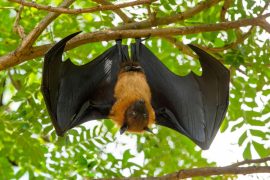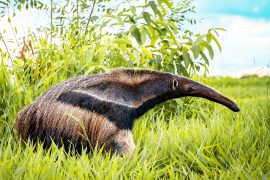Arthropods
Arthropods are prolific and ubiquitous animals that nearly cover the globe. You may have recently stepped on one accidentally, or even ate an arthropod during your last meal. Whatever the case, they are impossible to miss. Their staggering diversity has allowed them to succeed in almost every ecosystem, from frigid deep-sea waters to the hottest and driest of deserts. In terms of sheer numbers, they are usually the dominant type of animal in whichever ecosystem you find them in.
Arthropods are types of invertebrates - animals with no backbone. Other invertebrates include sponges, mollusks, worms, nematodes, and more. Arthropods come in a great variety of sizes and shapes. Most are quite small, as their size is partly limited by the amount of oxygen in the air. Some of the smallest arthropods are almost microscopic and less than half a millimeter wide, like some mites and parasitic wasps. Others, like the Japanese spider crab, can reach gargantuan sizes and measure nearly 4 meters (13 feet) across!

Arthropod Anatomy
The word “arthropod” is derived from the Ancient Greek words “arthro”, meaning “joint”, and “pous”, meaning “foot”. The etymology tells you the most important characteristic of the arthropod body - jointed appendages. In addition, arthropods have segmented bodies. Oftentimes, sensory organs, locomotion, and other internal organs are compartmentalized within specific segments. Segmentation also allows arthropods to move freely while still having a hardened exoskeleton. Here, we’ll cover the most important parts of arthropod anatomy.
Exoskeleton
Arthropods are unique in that they possess a hard exoskeleton: a non-cellular cuticle produced by the epidermis. This outer layer, made of chitin, protects their soft internal organs and muscles. Think of it as a protective casing for the animal rather than a layer of skin, as an exoskeleton does not contain any living cells. Other invertebrates, like some sponges, also have an exoskeleton.
Exoskeletons are part of why arthropods are so successful. This hard coating provides not only structural support, much like bones do for vertebrates, but also an effective method of protection for the animal. Many marine arthropods such as crustaceans incorporate calcium carbonate into their exoskeleton which they extract from the water. This, in turn, provides even more protection thanks to the extreme rigidity of calcium carbonate.

Molting
Because an exoskeleton is not flexible and of a fixed size, arthropods must occasionally shed their outer layer in order to grow larger. This process is referred to as molting and is a normal part of an arthropod’s life until it reaches its full size.
To begin a molt, an arthropod typically stops feeding temporarily and its epidermis releases enzymes that detach the animal from its outer casing. Then, the animal makes its body grow by taking in lots of water or air. This way, the arthropod’s body will outgrow the size of the exoskeleton and eventually cause a rupture in a weak part of the exoskeleton. The animal then squeezes its soft body out of the exoskeleton, which can take several minutes to hours.
At this point, the arthropod has not produced a new exoskeleton yet, and so it is extremely vulnerable. As the animal’s epidermis creates a new, hardened exoskeleton, it continues to take in as much water or air it can in order to reach a maximum size. Eventually, the exoskeleton hardens and the arthropod achieves a new, larger size than it was before. Some arthropods then proceed to eat their old exoskeleton, called an “exuvium”, in order to reclaim its materials and nutrients.
During the beginning stages of an arthropod’s life, molting is a frequent occurrence. As the animal matures, it molts less and less as its rate of growth decreases. Stages between molts are called instars. They can be unique in their sizes, colors, patterns, and they can even have unique body parts entirely. For example, insects grow wings only after their final molt when they reach their adult stage.

Sensory Organs
Arthropods, like most animals, sense the world around them in different ways in order to detect food, predators, and changes in their environment. We’ll go over the two sensory organs that all arthropods have mostly in common: touch and optics.
One potential problem of an exoskeleton is that it prohibits any method of feeling the surrounding environment since it is a non-cellular structure. Arthropods have evolved a way around this by producing setae, which are hair-like structures that protrude from specialized openings on the exoskeleton. Setae are especially abundant on organs such as antennae, mouthparts, joints, and limbs. Spiders, for example, have sensitive setae on their legs that can detect minute vibrations on the ground and sense prey.
The other sensory organs most arthropods have in common are compound eyes. These optical organs mostly sense the intensity and direction of light, but some arthropods can also see colors and shapes in high detail. Compound eyes are made up of ommatidia, which are narrow, tube-like structures all bundled together. Each ommatidium independently senses the intensity of light in a single point in space. The more ommatidia in a compound eye, the more detailed an image an arthropod sees. One species, the mantis shrimp, has such advanced compound eyes it can actually see more colors than humans!
Respiratory and Circulatory System
Arthropods have respiratory and circulatory systems that are quite different from that of vertebrates. Aquatic arthropods possess gills for respiration; they are covered by a thin layer of the exoskeleton that allows for gas exchange. Terrestrial arthropods have a more unique respiratory system. They possess tracheae, which are tiny tubes that transport external air to internal organs. Many arthropods, specifically the smallest ones, don’t need any sort of mechanism to pump air into their bodies. Instead, their small size allows for gasses to diffuse directly through their exoskeleton and provide their internal organs with oxygen.
Arthropods have an open circulatory system, which means there is no distinction between blood and interstitial fluid. The mix of the two, hemolymph, fills cavities in an arthropod’s body and bathes organs with oxygen and nutrients. Compare this to a closed circulatory system that vertebrates have, which consists of blood that never leaves a defined network of veins and arteries.
Muscles and Locomotion
Arthropods have a myriad of techniques to move around. Walking, jumping, swimming, flying, climbing, and digging are all common means of locomotion for an arthropod. With the exception of flying, arthropods use their segmented appendages and internal muscles to move around. As muscles contract, they work with the exoskeleton to produce a lever effect, analogous to vertebrate locomotion. Most arthropods have limbs splayed out to either side of the body, and can have as little as six legs as many as 750, as seen in a millipede species.

Arthropod Life Cycle and Reproduction
Most arthropods, with the notable exception of barnacles, are either male or female and must engage in sexual reproduction to produce offspring. Many arthropods engage in courtship behaviors in order to attract a mate, while others have males that battle each other for the privilege of mating with a female. During mating, sperm is often transferred from male to female in spermatophores, which are sealed packets that prevent sperm cells from desiccation on land or, in the case of aquatic arthropods, dilution by water.
Arthropods have somewhat complicated life cycles and go through a series of stages before reaching maturity. Although there isn’t one life cycle that can be applied to all arthropods, many go through common stages which are outlined here.
Most arthropods start out as eggs. These eggs hatch into larvae which often look nothing like the adult form. The earliest larval stage only has three pairs of appendages, and more appendages form during successive molts. In addition, larvae will often lack body segments and have a more stunted or simplistic body plan than the adult. Some insects hatch into a nymph instead of a larva, which superficially resembles the adult form but lacks reproductive organs and wings.

History and Evolution of Arthropods
The earliest fossil of an arthropod dates back to the Cambrian Period (541 million - 485.4 million years ago). These fossils are of trilobites, merostomes, and primitive crustaceans. Also in the fossil record are arthropods that don’t resemble any extant animal, representing some enigmatic groups that went extinct long ago. Arthropods made their first appearance on land around 450 million years ago and were likely the first animals to do so. A fossil from the Late Silurian period confirms that arthropods were roaming around on land at least 419 million years ago. Other arthropod fossils include whole specimens incredibly well preserved in amber, which can date back to the Triassic Period (251.9 million - 201.3 million years ago).
Arthropod Diversity
Out of all animal phyla on earth, Arthropoda is by far the largest. It is currently impossible to pin down exactly how many species of arthropods there are. Estimates put the number anywhere between 1,000,000 and 10,000,000, a staggering amount considering the next most diverse phylum, Mollusca, has an estimated 200,000 species. Because of the enormous diversity of arthropods and the increasing rate at which scientists describe new species, it will be difficult to know the exact diversity anytime soon. That said, we can say with confidence that arthropods account for over 80 percent of all living animal species!
Types of Arthropods
The next step down the taxonomic ladder from phylum is subphylum and then class. Each subdivision has its own features that make it unique. Here are the most important subphyla and classes within the phylum Arthropoda.

Trilobites (Class Trilobita)
First is a group of extinct but fascinating arthropods. Trilobites are one of the oldest classes and are well represented in the fossil record. They were incredibly successful animals that diversified during the Cambrian Explosion and filled nearly every ecological niche in the marine environment that arthropods do today. They eventually declined in diversity until they disappeared completely during the Permian-Triassic extinction event around 252 million years ago.
Chelicerates (Subphylum Chelicerata)
Chelicerates are one of the major subdivisions of arthropods and actually fit somewhere in between phylum and class. This name comes from the presence of chelicerae in these animals. Chelicerae are specialized appendages that appear before the mouth and aid in feeding. Some chelicerates have modified chelicerae that can be used to hunt and even inject venom into their prey. Animals within this subphylum include sea spiders, arachnids, and horseshoe crabs.

Arachnids (Class Arachnida)
Arachnids include spiders, scorpions, ticks, and mites. These arthropods have eight legs and are almost entirely terrestrial. They are a diverse group as well, containing over 100,000 species. Most arachnids have two body segments - a cephalothorax and an abdomen. However, some mites do not have any discernible separation between these body segments.
Horseshoe Crabs (Class Xiphosura)
The common name of this group is a bit of a misnomer. Horseshoe crabs are not actually crabs, nor are they even crustaceans. Instead, they make up their own class of arthropods. Modern horseshoe crabs are virtually unchanged from fossils that date back to 244 million years ago, making them living fossils. There are only four extant species of horseshoe crabs, and all are found mainly in shallow coastal waters.

Myriapods (Subphylum Myriapoda)
Myriapods get their name from Ancient Greek “myria”, meaning ten thousand, and “pous”, meaning foot. Although myriapods don’t literally have ten thousand feet, they have the most of all arthropods, and often have over 100 pairs of legs. Myriapods include millipedes (class Diplopoda), centipedes (class Chilopoda), and other, smaller classes.
Crustaceans (Subphylum Crustacea)
Crustaceans are a large group of arthropods and are largely aquatic in nature. They are unique in having biramous limbs, which means limb segments can split into two distinct segments rather than just one. They also have unique larval forms that other arthropods do not have. Here are three of the most important classes of arthropods.
Branchiopoda
This class includes fairy shrimp and clam shrimp. They are generally very small and have gills that are uniquely located on appendages and even mouthparts. They mainly inhabit freshwater ecosystems, and can even survive in temporary pools that dry up for part of the year.
Maxillopoda
Maxillopoda includes barnacles, copepods, and related animals. This class does not have a single characteristic that unites all of its members, and may actually not even be a monophyletic group.

Malacostraca
Malacostraca is by far the largest class of crustaceans. In this group are crabs, lobsters, crayfish, shrimp, krill, woodlice, amphipods, and mantis shrimp. They are all defined by having 20 body segments divided into a head, thorax, and abdomen. This class is regarded as having the greatest diversity of body forms among all classes in the animal kingdom.
Hexapods (Subphylum Hexapoda)
Hexapods are the most diverse group of arthropods in terms of number of species. They get their name from their six legs which are consolidated on the thorax. They also possess a head and abdomen, a similar body plan to that of the class Malacostraca. Three very small groups of arthropods are in this subphylum - Collembola (springtails), Protura, and Diplura (bristletails). In addition, the most diverse class of arthropods is in this group, the insects.
Insects (Class Insecta)
The next group, the insects, are a remarkably diverse group of arthropods, containing well over 1,000,000 species. Insects are the only group of arthropods with wings, which develop after their final molt during their adult stage. However, not all insects have wings, as some have actually lost their ability to fly over time.
Humans and Arthropods
Arthropods are inescapable features of everyday life for humans. For one, they make up important food items for cultures around the world and are often raised commercially. Coastal communities around the globe eat crustaceans. In addition, insects have huge potential to provide humans with an alternative source of protein, as they are much more sustainable to raise than livestock.
Some arthropods also threaten human lives by being vectors of disease. The mosquito, a type of fly, is often considered the most deadly animal on earth due to its ability to spread malaria, yellow fever, and other illnesses. Many arthropods are also serious agricultural and forest pests. Entire industries are built around eradicating and controlling arthropod pests, most notably pesticides. Forest pests include invasive species, which are wiping out certain types of trees faster than we can control them. The emerald ash borer, for one, is devastating ash trees across North America. In addition, cockroaches and termites are common pests in homes and urban areas.
Despite many negative effects arthropods have on human life, there are many we simply can’t live without. Insect pollinators are crucial for maintaining global crop production, and without them, humans would quickly starve. Other arthropods are vital for medicinal purposes. For example, horseshoe crabs contain special cells in their blood which we harvest and use as a necessary ingredient in vaccines. These cells bind to toxins and ensure vaccines are free of contamination. We haven’t yet developed artificial compounds that mimic the function of these cells, and so we rely entirely on horseshoe crabs to ensure our vaccines are safe.

Conclusions
Arthropods, being the most diverse and abundant group of animals, have evolved into a variety of forms and fill every ecological niche on the planet. They also have fascinating and unique life-history traits, which we are still learning more about each and every day. Scientists discover new species continuously, and no other group of organisms will surpass them in terms of diversity or abundance. They are also impossible to live without, and although they provide challenges to human life, they also provide us with incredible benefits.
families in arthropoda
Jump to families starting with:
News coming your way


























